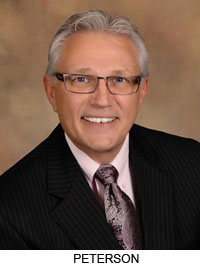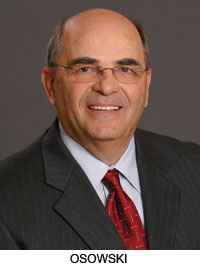MA market’s downside could be a deal-breaker
February 11, 2015
By Tom Peterson, Hank Osowski
![]() [Printable Version]
[Printable Version]
There are two undeniable truths.
The first is that Medicare-eligible citizens now represent the fastest-growing segment of the American population, making it more important than ever for the healthcare industry – as well as society as a whole – to find effective ways to address the health and social needs of this burgeoning population.
 The second truth is that a growing number of seniors – now 16 million or roughly 31% of all Medicare beneficiaries – are enrolling in Medicare Advantage (MA) plans and, for the most part, are living these plans high marks. A recent study released by America’s Health Insurance Plans (AHIP) reports that nine out of 10 seniors are satisfied with their MA plan, particularly as it pertains to quality of care, out-of-pocket costs and benefits received.
The second truth is that a growing number of seniors – now 16 million or roughly 31% of all Medicare beneficiaries – are enrolling in Medicare Advantage (MA) plans and, for the most part, are living these plans high marks. A recent study released by America’s Health Insurance Plans (AHIP) reports that nine out of 10 seniors are satisfied with their MA plan, particularly as it pertains to quality of care, out-of-pocket costs and benefits received.
The confluence of these two factors is making it increasingly seductive for commercial health plans, Accountable Care Organizations (ACOs), hospitals, physicians and assorted entrepreneurs to consider entering the MA market as a business opportunity ripe for reward. After all, on the surface this market contains many of the elements needed for business success, from changing demographics moving in its favor to market receptivity for the product category. In addition, savvy healthcare observers note that the financial model needed for MA success is favorable as an increasing number of providers are accepting capitation given that all government programs (including Medicare, Medicaid and health insurance exchanges) are rapidly moving to reimbursement under a value-based model.
But lurking behind this idyllic picture is another side of the industry that can bring the curtain down on even those with the noblest of intents. That’s because the MA industry is one fraught with regulation, dependent on a single payer – the Centers for Medicare and Medicaid Services (CMS) – operating on slim margins, reliant on provider cooperation, hostage to the introduction of costly new specialty drugs, and engulfed in consolidations that give mega brands a decided competitive advantage.
To be or not to be – that is the question for those considering entering the MA marketplace. So before making the leap, it is wise to consider some of the strategies for success and where your organization falls on this perilous barometer.
Success begins with having unified organizational commitment, both strategically and financially, to embark on this venture. This also means having the patience and financial wherewithal needed during the start-up years, even if that requires putting a strain on existing tight resources. More than blind commitment, which can be dangerous, leadership needs to fully understand the breadth of both the opportunity and risk involved as well as how the plan-development strategy meshes with broader corporate initiatives. That is often best obtained by leveraging experienced Medicare-knowledgeable advisors early in the process, before the initiative is already baked. Such advisors bring objectivity, perspective and road-tested experience to the table. They can also be invaluable in filing the application for licensure, designing business processes around current regulations, and in helping to obtain the right expertise and experience to run the plan once it is operational.
Healthcare organizations considering starting an MA plan must also objectively look at their current footprint in their existing market and ask themselves if that presence is strong enough and trusted enough to build the provider network needed for success. Beyond simply sheer number of providers, these partners need to be aligned philosophically, culturally and financially; and that means establishing a network that promotes (and incentivizes) health plan/provider collaboration and supports the kind of risk adjustment model that will be necessary in today’s environment. MA plans can leave millions of dollars on the table if they don’t get this right.
 Ultimately, all MA plans sink or swim based, in great part, on their ability to manage the cost of care provided to their members … and the amount of care these members utilize. The key for MA plans, therefore, is in knowing the health status of their members so they can determine what conditions should be treated and where there are gaps in care … and then be properly reimbursed for the services they provide. Through the use of advanced data-pursuit algorithms to target and obtain missing data, programs exist today that not only give health plans and providers the ability to correct inaccuracies or gaps in care, but provide early warning indicators that lead to better quality management. Start-up MA plans (as well as existing plans) would be wise to avail themselves of such technologies if they are to achieve the dual goal of enhancing quality of care while assuring their own profitability.
Ultimately, all MA plans sink or swim based, in great part, on their ability to manage the cost of care provided to their members … and the amount of care these members utilize. The key for MA plans, therefore, is in knowing the health status of their members so they can determine what conditions should be treated and where there are gaps in care … and then be properly reimbursed for the services they provide. Through the use of advanced data-pursuit algorithms to target and obtain missing data, programs exist today that not only give health plans and providers the ability to correct inaccuracies or gaps in care, but provide early warning indicators that lead to better quality management. Start-up MA plans (as well as existing plans) would be wise to avail themselves of such technologies if they are to achieve the dual goal of enhancing quality of care while assuring their own profitability.
Toward that end successful MA plans must design a care management and quality management program that optimizes CMS star ratings and HEDIS scores. As of this year CMS is paying plans based on the quality of care provided to their members – the higher the star rating, the more dollars plans receive – and only four- and five-star plans are receiving any quality bonus payments at all. For MA plans star ratings are no longer simply a “nice to have” or a tagline in an ad: they are a critical component of financial sustainability and sound stewardship. Here again the accurate collection and sharing of data is essential. This includes the careful tracking of the health status of members with a particular focus on wellness initiatives, gaps in care, and ongoing monitoring of chronic conditions.
Entering the MA space can be an exciting strategy for commercial plans looking to expand their product portfolio or for ACOs and hospitals seeking new ways, and new revenue streams, to serve a rapidly growing demographic in their community. But proceed with caution and with good partners, for succeeding in this marketplace requires solid thinking, sound planning, business discipline and
ongoing focus.
Tom Peterson is president and chief executive officer of Clear Vision Information Systems, which helps MA plans and the physicians who work with them improve their own profitability as well as the health and quality of life of their patients. Hank Osowski is co-founder and managing director of Strategic Health Group, which provides healthcare organizations with a wide range of consulting services including strategic planning, corporate finance and treasury, marketing communications, actuarial services, human capital and many others.
